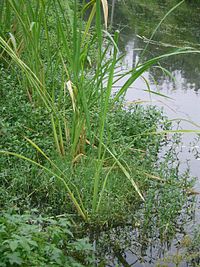
Photo from wikipedia
KEY MESSAGE Knocking out OsVQ1 in rice released OsMPK6 for activation and in turn promoted H2O2 accumulation, which repressed the expression of flowering-promoting genes, thus delaying rice flowering but enhancing… Click to show full abstract
KEY MESSAGE Knocking out OsVQ1 in rice released OsMPK6 for activation and in turn promoted H2O2 accumulation, which repressed the expression of flowering-promoting genes, thus delaying rice flowering but enhancing disease resistance. The valine-glutamine (VQ) protein family, which contains the conserved motif FxxxVQxLTG ("x" represents any amino acid), plays a crucial role in plant growth and immunity along with mitogen-activated protein kinase (MAPK) cascades. However, only a few rice VQ proteins have been functionally characterized, and the roles of the MAPK-VQ module in rice biological processes are not fully understood. Here, we investigated the role of OsVQ1 in rice disease resistance and the control of flowering time. The OsVQ1-knock out (KO) mutants exhibited increased resistance to Xanthomonas oryzae pathovars, accumulated high levels of hydrogen peroxide (H2O2), and showed a late flowering phenotype under natural long-day conditions, while the OsVQ1-overexpressing plants showed phenotypes similar to that of the wild type. Further studies revealed that OsVQ1 physically interacted with and inhibited OsMPK6 activity. In addition, OsVQ1 expression was downregulated by the pathogen-induced OsMPKK10.2-OsMPK6-OsWRKY45 cascade, suggesting a feedback loop between OsVQ1 and OsMPK6. Moreover, the OsVQ1-KO/osmpk6 double-mutant exhibited increased susceptibility to X. oryzae infection and showed an early flowering phenotype, which may partially be attributed to the reduced accumulation of H2O2 and the consequent up-expression of flowering-promoting genes. These results suggested that the OsVQ1-OsMPK6 module was involved in rice immunity and flowering.
Journal Title: Plant cell reports
Year Published: 2021
Link to full text (if available)
Share on Social Media: Sign Up to like & get
recommendations!